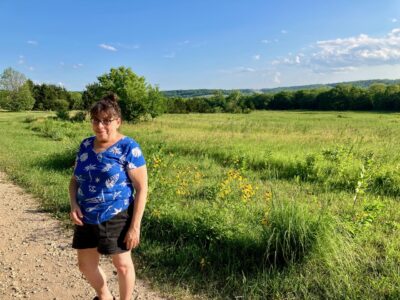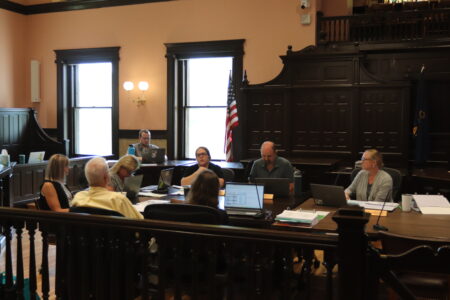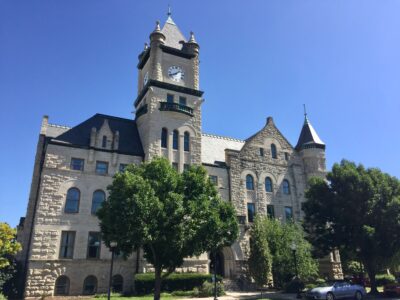Lawrence author’s new memoir is about how she survived eye cancer and helped preserve a piece of Kansas prairie forever

photo by: Ken Lassman
Lawrence author Caryn Mirriam-Goldberg is pictured on her family's land near Wells Overlook in July 2025.
A struggle with eye cancer and a struggle to preserve a piece of land will forever be intertwined in the memory of Lawrence author Caryn Mirriam-Goldberg.
Mirriam-Goldberg, a prairie advocate, two-time cancer survivor, one-time poet laureate — and now “one-eyed woman,” as she matter-of-factly puts it — is launching her latest book this week.
Titled “The Magic Eye: A Story of Saving a Life and a Place in the Age of Anxiety,” the book is the latest memoir by Mirriam-Goldberg, who left New York decades ago for the big skies and wide-open spaces of Kansas. She has since become one of the Sunflower State’s most beloved — and most prolific — authors.
“I’m a writer, and whatever life throws at me I write about,” she said, noting that this is her 26th book and “fifth or sixth memoir, depending on how you count.”
What life threw at her in 2019 was “the shock and surprise of eye cancer” at the age of 59.
Like her mother and aunts, she had already dealt with breast cancer in her early 40s, but eye cancer was a terrifying unknown. She didn’t even know it existed.
The issue first came to her attention when a good friend, over lunch, said, “What’s up with your eye? It keeps twitching.”
The question, and ensuing blurriness in her right eye, prompted a series of stressful doctors’ visits that eventually led to a diagnosis of ocular melanoma, a rare and often deadly cancer.
Part of Mirriam-Goldberg’s treatment involved having a gold disc with radioactive pellets surgically implanted into her eye for five days, during which time she was considered radioactive and strictly confined in her movements.
The memoir chronicles the medical and emotional ordeal but also how life — even an actual tornado, like the one that narrowly missed her family’s rural Lawrence home or the COVID pandemic that struck soon after — comes at you fast, bringing chaos, but also moments of poignant beauty, like the pair of red cowgirl boots a friend gifted her during the long “rodeo” of cancer treatment.
In the end — if it can be called that — her eye was saved, but not her vision. She is now legally blind in her right eye, but she has this clarity: “Big dances with mortality show us more of our essential being, and that is a priceless gift of perspective,” she writes in the memoir.
She also knows this: “You can do a lot as a one-eyed woman,” she told the Journal-World. “There are a lot of people who turn out to have one eye that doesn’t work, so I’ve learned a lot about that.”
That is the sight part of her memoir. The site part — the “Place” in its title — has personal, but also public, significance, as it refers to saving a prairie on the outskirts of southern Lawrence that could easily have been divided up and developed, changing the rural landscape forever.
That land surrounds Wells Overlook, a well-known park to Douglas County residents, which was donated to Douglas County in 1971 by her husband’s grandfather, William Wells.
The family of her husband, Ken Lassman, owned the property surrounding the overlook for generations. She and Lassman, an occupational therapist and nature writer, built their current home on five acres of that land, where they raised their family and drew inspiration from the native flora and fauna — and a slew of domesticated animal friends.
Other land surrounding the overlook, about 130 acres total, was owned by Ken’s mother and her four sisters in what Mirriam-Goldberg describes as “an almost irrevocable trust.” Ken’s mother, who died in 2018, tried to buy the land from her sisters but wasn’t successful. Most of the owners wanted to preserve the land as an ecological and family legacy, but not all of them did.
Eventually, after some drama, the trust was dissolved and the opportunity to purchase the land — albeit at fair market value — was given to Mirriam-Goldberg and Lassman. They saved money and re-mortgaged their paid-off house “to the hilt” in order to buy the land. Then they donated the development rights to the Kansas Land Trust, whose mission is to protect land of ecological, agricultural, cultural or recreational significance in the state.
To help finance the land purchase, they couple sold two 20-acre plots within the parcel to two parties “who also love the land.”
“We now own 90 acres, and two other parties own about 20 acres each, so it’s a conservation easement with three sets of owners,” Mirriam-Goldberg said, and none of the land, which they consider a wildlife refuge, can be plowed up, deforested or developed into apartment complexes or suburban housing as Lawrence creeps southward.
The eye cancer and the land drama both happened at the same time — with pandemic anxiety coloring all of it — and for Mirriam-Goldberg those years have become a single lyrical story about life being saved and land being saved.
“So this is a memoir about all of that,” she said, “and I would say even more so it’s kind of about a big, somewhat amorphous subject, which is how do we live? How do we see the world in meaningful ways? How do we find a narrative that really is generous and generative and contributes something to our own callings in the world?”
Mirriam-Goldberg is launching “The Magic Eye” with a party at 7 p.m. Thursday at The Raven Book Store, 809 Massachusetts St. The event will feature a reading, a question-and-answer session, special guests and refreshments. After the launch, she’ll be participating in more than a dozen other book-related events this summer and into autumn, including a reading in Ireland. For a complete list, check out carynmirriamgoldberg.com/magic-eye.






